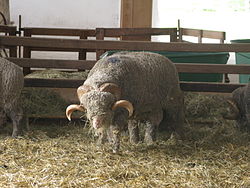
The Rambouillet is a breed of sheep in the genus Ovis. It is also known as the Rambouillet Merino or the French Merino.

The Rambouillet is a breed of sheep in the genus Ovis. It is also known as the Rambouillet Merino or the French Merino.
The development of the Rambouillet breed started in 1786, when Louis XVI purchased over 300 Spanish Merinos (318 ewes, 41 rams, seven wethers) from his cousin Charles III of Spain. The flock was subsequently developed on an experimental royal farm, the Bergerie royale (now Bergerie nationale) built during the reign of Louis XVI, at his request, on his domain of Rambouillet, 50 km southwest of Paris, which Louis XVI had purchased in December 1783 from his cousin Louis Jean Marie de Bourbon, Duke of Penthièvre. The flock was raised exclusively at the Bergerie, with no sheep being sold for several years, well into the 19th century. [1]
Outcrossing with English long-wool breeds and selection produced a well-defined breed, [2] differing in several important points from the original Spanish Merino. The size was greater, with full-grown ewes weighing up to 200 lb and rams up to 300 lb. The wool clips were larger and the wool length had increased to greater than 3 in (80 mm).
In 1889, a Rambouillet Association was formed in the United States by Larmon Bronson Townsend & Larmon George Townsend in Ionia, Michigan, with the aim of preserving the breed. [3] An estimated 50% of the sheep on the US western ranges are of Rambouillet blood. [4] Rambouillet stud has also had an enormous influence on the development of the Australian Merino industry through Emperor and the Peppin Merino stud.
The fleece was valuable in the manufacture of cloth, at times being woven in a mixed fabric of cotton warp and wool weft. [5]
The breed is well known for its wool, but also for its meat, both lamb and mutton. It has been described as a dual-purpose breed, with superior wool and near-mutton breed characteristics. This breed was also used for the development of the "Barbado" or American Blackbelly sheep, which was crossed with Barbados Blackbelly and mouflon for their horns at hunting ranches. [6] [7]

The Merino is a breed or group of breeds of domestic sheep, characterised by very fine soft wool. It was established in Spain near the end of the Middle Ages, and was for several centuries kept as a strict Spanish monopoly; exports of the breed were not allowed, and those who tried risked capital punishment. During the eighteenth century, flocks were sent to the courts of a number of European countries, including France, Hungary, the Netherlands, Prussia, Saxony and Sweden.
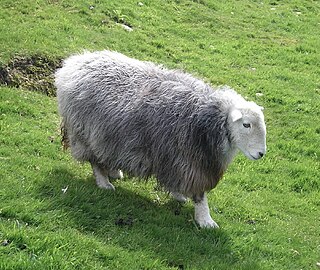
The Herdwick is a breed of domestic sheep native to the Lake District in North West England. The name "Herdwick" is derived from the Old Norse herdvyck, meaning sheep pasture. Though low in lambing capacity and perceived wool quality when compared to more common commercial breeds, Herdwicks are prized for their robust health, their ability to live solely on forage, and their tendency to be territorial and not to stray over the difficult upland terrain of the Lake District. It is considered that up to 99% of all Herdwick sheep are commercially farmed in the central and western Lake District.

The Border Leicester is a British breed of sheep. It is a polled, long-wool sheep and is considered a dual-purpose breed as it is reared both for meat and for wool. The sheep are large but docile. They have been exported to other sheep-producing regions, including Australia and the United States.

The Romney, formerly called the Romney Marsh sheep but generally referred to by the local farmers as the Kent, is a breed of sheep originating in England. The Romney is a "long-wool" breed recognized in England by 1800. Exported to other continents, the Romney is an economically important sheep breed, especially to the sheep-meat and wool export trades of New Zealand.

The Targhee is an American breed of domestic sheep. It was developed in the early twentieth century at the U.S. Sheep Experiment Station of the Agricultural Research Service of the United States Department of Agriculture at Dubois, Idaho, and is named after the Targhee National Forest which surrounds it. It is a dual-purpose breed, with heavy, medium-quality wool and good meat production characteristics. It is hardy and well-suited to the ranges of the West where it was developed. It is kept mainly in Montana, Wyoming and South Dakota, and is reared primarily for wool.
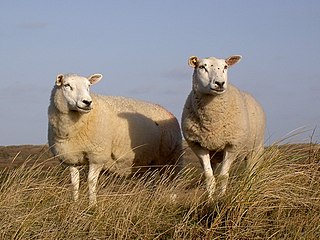
The Texel is a Dutch breed of domestic sheep originally from the island of Texel. It is a heavy and muscular sheep, and produces a lean meat carcass. It is polled, clean-faced and clean-legged, with white face and wool. The fibre diameter of the wool averages about 32 μ, with a staple length of 8–15 cm; it is used mainly for knitting and hosiery wools.
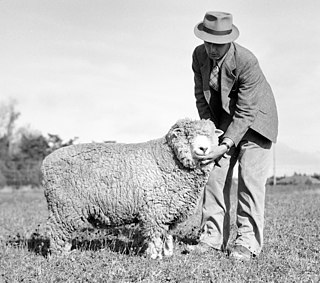
The Corriedale is a New Zealand breed of sheep. It was bred from about 1882 in the South Island by James Little, who cross-bred Merino and Lincoln Longwool sheep. The breed was officially recognised in 1911. It has been exported to Australia and to many countries in Africa, Asia, Europe and North and South America. In 2021 it was reported from twenty-five countries, and the total population was estimated at just over 5 million.

The Peppin Merino is a breed of Merino sheep raised for their wool, mostly in Australia. So important is the Peppin Merino that wool producers throughout Australia often classify their sheep simply as being either Peppin, or non-Peppin.

The Poll Merino is a subtype of the Australian Merino breed of domestic sheep, without horns, that was developed in Australia.

The Columbia is one of the first breeds of sheep developed in the United States. The product of USDA and university research, it was intended to be an improved breed adapted for the Western ranges of the country.
The Debouillet is a breed of domestic sheep originating from Tatum, New Mexico. It was developed in the 1920s through crossing Rambouillet and Delaine Merino sheep and the breed's name is a portmanteau of these two ancestors. This breed is primarily raised for its wool.

Sheep or domestic sheep are a domesticated, ruminant mammal typically kept as livestock. Although the term sheep can apply to other species in the genus Ovis, in everyday usage it almost always refers to domesticated sheep. Like all ruminants, sheep are members of the order Artiodactyla, the even-toed ungulates. Numbering a little over one billion, domestic sheep are also the most numerous species of sheep. An adult female is referred to as a ewe, an intact male as a ram, occasionally a tup, a castrated male as a wether, and a young sheep as a lamb.
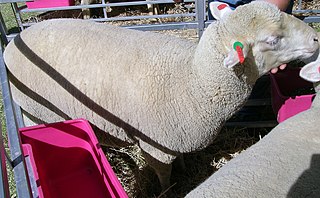
The South African Meat Merino or SAMM is a wool and meat sheep originating in South Africa, but now found throughout the world.
The British Milksheep is a robust, dual-purpose sheep commonly known for its milking characteristics.
The Comeback is a type of domestic sheep originating in Australia. This type of sheep results from crossbreds produced by British Longwool sheep and Merinos being mated back to Merinos. This cross is made to achieve a finer, better style of wool. Comeback style wool is also produced by Bond, Cormo and Polwarth sheep and they may prove easier to breed than Comebacks. The Comeback sheep are raised for meat and their fine wool.
The Dohne Merino is a breed of domestic sheep from South Africa. The breed was started in the late 1930s by the South African Department of Agriculture. It was developed by interbreeding Peppin-style Merino ewes and German Mutton Merino rams. The Dohne Merino is a dual purpose breed providing meat and fine wool.
The Eliottdale is a breed of domestic sheep originating from Tasmania. It is a carpet wool breed raised primarily for its wool. Due to the amount of wool grown by the Eliottdale, it needs to be shorn twice per year.

The history of the domestic sheep goes back to between 11,000 and 9,000 BC, and the domestication of the wild mouflon in ancient Mesopotamia. Sheep are among the first animals to have been domesticated by humans. These sheep were primarily raised for meat, milk, and skins. Woolly sheep began to be developed around 6000 BC. They were then imported to Africa and Europe via trading.

Sheep farming is a significant industry in New Zealand. According to 2007 figures reported by the Food and Agriculture Organization (FAO) of the United Nations, there are 39 million sheep in the country. The country has the highest density of sheep per unit area in the world. For 130 years, sheep farming was the country's most important agricultural industry, but it was overtaken by dairy farming in 1987. Sheep numbers peaked in New Zealand in 1982 to 70 million and then dropped to about 27.6 million. There are 16,000 sheep and beef farms in the country which has made the country the world's largest exporter of lambs, with 24 million finished lambs recorded every year.
The Sopravissana is a breed of domestic sheep from the province of Macerata, in the Marche in central Italy. The name derives from the area of origin, the comune of Visso in the Monti Sibillini; it was traditionally raised mostly in that area, but flocks ranged into Lazio, Tuscany and Umbria. The Sopravissana derives from the cross-breeding of local ewes with Spanish and Rambouillet Merino rams in the 18th century. It is larger than the Vissana breed from the same area.
{{cite book}}: |work= ignored (help)